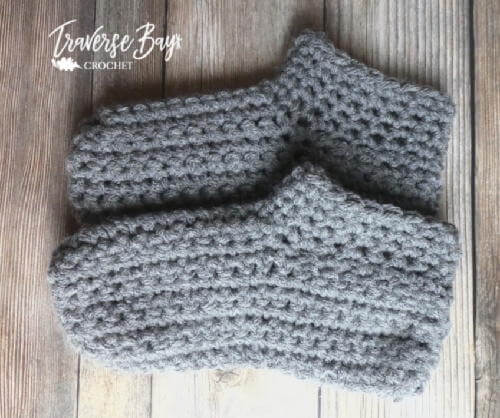Easy Peasy Child Slippers The Perfect Beginner-Friendly Crochet Project
In this comprehensive guide, I’ll walk you through everything you need to know to create your own Easy Peasy Child Slippers, from selecting the right materials to adding those finishing touches that make them extra special.
Whether you’re new to crochet or looking to expand your repertoire with a fun, practical project, these slippers are sure to become a staple in your crafting collection.
What Makes These Child Slippers So “Easy Peasy”?
Before we dive into the materials and instructions, let’s talk about what makes these Easy Peasy Child Slippers particularly beginner-friendly:
- They primarily use simple stitches like single crochet (no complicated stitch patterns to memorize)
- The construction is straightforward with minimal shaping
- They work up quickly, providing that satisfying feeling of completion
- The pattern is forgiving and adaptable to different foot sizes
- They’re perfect for practicing basic crochet skills in a practical project
Even if you’ve only recently learned how to hold a crochet hook, you can successfully complete these slippers. And if you’re more experienced, you’ll appreciate how quickly they work up and how easily they can be customized.
Find the Free Crochet Pattern Here
Materials You’ll Need
Yarn Selection
For the Easy Peasy Child Slippers, you’ll want to choose a yarn that’s both comfortable and durable. Here are my recommendations:
- Medium (worsted) weight yarn (size 4): This is the ideal weight for most children’s slippers as it creates a fabric that’s neither too bulky nor too thin
- 1 skein (approximately 200-250 yards) for most child sizes
- Fiber content options:
- Acrylic yarn: Budget-friendly and easy to wash, perfect for growing kids (Red Heart Super Saver or Bernat Premium work well)
- Wool blend: Offers more warmth and natural fiber benefits while still being machine washable (Lion Brand Wool-Ease is a great option)
- Specialty slipper yarn: Phentex Slipper & Craft Yarn is specifically designed for slippers and offers excellent durability
For the youngest children, you might consider using a softer yarn for extra comfort against delicate skin. For older, more active children, prioritize durability with a sturdier yarn option.
If you’re unsure about which yarn to choose, Yarnspirations offers an excellent guide to selecting the right yarn for different projects, including children’s footwear.
Hook Size
For these slippers, you’ll need:
- Size H-8 (5.0mm) hook for most children’s sizes
- Size I (5.5mm) hook for a looser tension or larger sizes
The hook size can be adjusted based on your personal tension and the specific yarn you choose. Remember that using a larger hook will create a looser, more flexible slipper, while a smaller hook will create a denser, more structured slipper.
If you’re new to crochet and unsure about hook sizes, Crochet.com offers a comprehensive guide to understanding how hook size affects your project.
Additional Notions
- Yarn needle for weaving in ends
- Scissors
- Measuring tape (to measure the child’s foot)
- Stitch markers (optional, but helpful for beginners)
- Materials for non-slip soles (we’ll discuss options later)
Size Chart for Different Age Groups
Getting the right size is crucial for comfortable, wearable slippers. Here’s a handy chart to help you determine the right size for your child:
| Age Group | Shoe Size | Foot Length (inches) | Slipper Length |
|---|---|---|---|
| 1-2 years | 4-5 | 4.5-5 inches | 4.75 inches |
| 2-3 years | 6-7 | 5-5.5 inches | 5.25 inches |
| 3-4 years | 8-9 | 5.5-6 inches | 5.75 inches |
| 4-5 years | 10-11 | 6-6.5 inches | 6.25 inches |
| 6-7 years | 12-13 | 6.5-7 inches | 6.75 inches |
| 8-9 years | 1-2 | 7-7.5 inches | 7.25 inches |
| 10-12 years | 3-5 | 7.5-8.5 inches | 8 inches |
For the most accurate fit, I always recommend measuring the child’s foot directly. Have them stand on a piece of paper, trace around their foot, and measure the length from heel to toe. Then add about 1/4 inch for comfort.
The Craft Yarn Council provides comprehensive foot size charts if you need additional guidance on sizing for children of different ages.
Step-by-Step Instructions for Easy Peasy Child Slippers
Now let’s get to the fun part—making the slippers! I’ll break this down into clear, manageable steps with all crochet terms fully written out (no confusing abbreviations here!).
Preparation
- Measure the child’s foot or refer to the size chart above to determine the appropriate slipper size.
- Select your yarn and appropriate hook size.
- Make a slip knot on your hook.
Creating the Sole
- Chain foundation: Chain enough stitches to match the length of the foot plus 1. For example, for a 5.75-inch foot, you would chain approximately 20-22 stitches. (The exact number will depend on your tension and yarn choice.)
- Row 1: Single crochet in the second chain from the hook and in each chain across. Chain 1 and turn. (You should have one less single crochet than your original chain count.)
- Rows 2-6: Single crochet in each single crochet across. Chain 1 and turn. (For smaller sizes, you might only need 4-5 rows; for larger sizes, you might need 7-8 rows. The width should be approximately half the length of the foot.)
- Do not fasten off when you complete the sole rectangle.
Creating the Upper Part
- Round 1: Working around the entire rectangle, single crochet evenly around all four sides of your rectangle. Place 3 single crochets in each corner to create a smooth curve. Join with a slip stitch to the first single crochet.
- Round 2: Chain 1. Single crochet in each single crochet around, working in the back loops only. This creates a nice ridge that defines the sole. Join with a slip stitch to the first single crochet.
- Rounds 3-7: Chain 1. Single crochet in each single crochet around. Join with a slip stitch to the first single crochet. (The number of rounds will depend on the size of the slipper and how high you want the upper part to be.)
Creating the Cuff
- Round 1 of cuff: Chain 1. Single crochet in each single crochet around, but this time work in both loops. Join with a slip stitch to the first single crochet.
- Round 2 of cuff: Chain 1. Single crochet in each single crochet around. Join with a slip stitch to the first single crochet.
- Round 3 of cuff: Chain 1. Single crochet in each single crochet around. Join with a slip stitch to the first single crochet.
- Fasten off and weave in ends.
Finishing Touches
- Fold the cuff down for a polished look.
- Add non-slip soles (see section below).
- Add any decorative elements if desired (buttons, small appliqués, etc.).
If you’re new to any of these basic crochet stitches, Bella Coco Crochet offers excellent tutorials with both written and video instructions to help you master these techniques.
Tips for Success with Your Easy Peasy Child Slippers
Gauge and Tension
While this pattern is forgiving, maintaining consistent tension throughout your project will give you the best results. If you’re new to crochet, practice the single crochet stitch before starting to get comfortable with maintaining even tension.
Counting Stitches
For beginners, it can be helpful to count your stitches at the end of each row or round to ensure you’re maintaining the correct number. Using stitch markers can be particularly helpful for keeping track of your place in the pattern.
Fitting Tips
- Make the sole slightly smaller than the actual foot measurement—crochet fabric stretches with wear.
- If you’re between sizes, choose the larger size for growing room.
- Have the child try on the slipper after completing the sole and first few rounds of the upper to check the fit before proceeding.
Common Troubleshooting
- Slipper too tight: Use a larger hook size or add a few more chains to your foundation.
- Slipper too loose: Use a smaller hook or decrease your starting chain by 1-2 stitches.
- Uneven edges: Practice maintaining consistent tension and make sure you’re not accidentally adding or skipping stitches.
For more tips on creating comfortable items for children, check out The Woobles, which specializes in child-friendly crochet projects.
Non-Slip Sole Options for Safety
Children’s slippers need non-slip soles to prevent accidents on smooth floors. Here are several effective options:
Commercial Products
- Puffy Fabric Paint: Apply dots or patterns of dimensional fabric paint to the bottom of the slippers. Allow to dry completely (usually 24 hours) before wearing.
- Silicone Caulk: Apply a thin layer of clear silicone caulk to the soles in a pattern of dots or lines. This creates a very durable non-slip surface.
- Commercially Available Non-Slip Pads: Products like Dritz Anti-Skid Gripper Fabric can be cut to size and sewn onto the soles.
DIY Solutions
- Shelf Liner Method: Cut non-slip shelf liner to match the shape of the sole and stitch it securely to the bottom of the slipper.
- Hot Glue Method: Create dots or patterns with hot glue on the soles. This is a quick solution but may need to be reapplied periodically.
- Leather or Suede Soles: Cut leather or suede to match the sole shape and stitch it to the bottom of the slipper for a durable, non-slip surface.
For detailed instructions on adding non-slip soles to your slippers, The Crochet Crowd offers an excellent tutorial with multiple techniques.
Customization Ideas for Your Easy Peasy Child Slippers
One of the joys of making these slippers is how easily they can be customized. Here are some fun ideas to make your Easy Peasy Child Slippers unique:
Color Variations
- Use the child’s favorite color
- Create rainbow stripes by changing colors every few rows
- Make seasonal slippers (orange and black for Halloween, red and green for Christmas)
- Use team colors for the sports-loving child
Decorative Elements
- Add small crocheted flowers or stars
- Attach buttons or pompoms to the cuff
- Embroider the child’s initials or a simple design
- Add small jingle bells for toddlers (securely attached, of course)
Structural Variations
- Add a Mary Jane strap across the top
- Create a high-top version by extending the ankle portion
- Add a drawstring around the ankle for a secure fit
- Create a moccasin style by adding a tongue piece
Themed Variations
- Animal slippers with ears and faces
- Superhero-inspired designs
- Princess or fairy slippers with sparkly yarn
- Monster slippers with googly eyes
Remember that any decorative elements should be securely attached, especially for younger children, to prevent choking hazards.
Why Handmade Slippers Make Wonderful Gifts
These Easy Peasy Child Slippers make thoughtful gifts for several reasons:
- Practicality: Unlike many children’s gifts that are quickly outgrown or forgotten, slippers are used daily.
- Personalization: When you make slippers yourself, you can customize them perfectly for the recipient.
- Comfort: Handmade slippers can be more comfortable than mass-produced options, as you can adjust the fit.
- Sustainability: Creating handmade items reduces the need for mass-produced products and their associated environmental impact.
- Showing Care: There’s something special about receiving an item someone made by hand just for you.
Consider making these slippers as birthday gifts, holiday presents, or as a special treat for a child who needs a little extra comfort.
Caring for Your Handmade Slippers
To ensure your Easy Peasy Child Slippers last as long as possible:
- Washing: Follow the care instructions for your chosen yarn. Most acrylic yarns can be machine washed on a gentle cycle and laid flat to dry.
- Repairs: Keep a small amount of the yarn used for potential repairs. The toe area often wears out first and can be reinforced or repaired as needed.
- Storage: Store slippers in a dry place when not in use to prevent moisture buildup.
- Refreshing: If slippers begin to lose their shape, they can often be gently washed and reshaped while damp.



